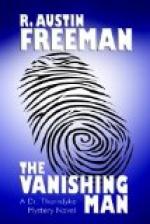“Then we know nothing. He may have had a motive for murdering the man or he may not. The point is that he doesn’t seem to have had the opportunity. Even if we suppose that he managed to conceal the body temporarily, still there was the final disposal of it. He couldn’t have buried it in the garden with the servants about; neither could he have burned it. The only conceivable method by which he could have got rid of it would have been that of cutting it up into fragments and burying the dismembered parts in some secluded spots or dropping them into ponds or rivers. But no remains of the kind have been found, as some of them probably would have been by now, so that there is nothing to support this suggestion; indeed, the idea of murder, in this house at least, seems to be excluded by the search that was made the instant the man was missed.
“Then to take the third alternative: Did he leave the house unobserved? Well, it is not impossible, but it would be a queer thing to do. He may have been an impulsive or eccentric man. We can’t say. We know nothing about him. But two years have elapsed and he has never turned up, so that if he left the house secretly he must have gone into hiding and be hiding still. Of course, he may have been the sort of lunatic who would behave in that manner or he may not. We have no information as to his personal character.
“Then there is the complication of the scarab that was picked up in the grounds of his brother’s house at Woodford. That seems to show that he visited that house at some time. But no one admits having seen him there; and it is uncertain, therefore, whether he went first to his brother’s house or to Hurst’s. If he was wearing the scarab when he arrived at the Eltham house, he must have left that house unobserved and gone to Woodford; but if he was not wearing it he probably went from Woodford to Eltham and there finally disappeared. As to whether he was or was not wearing the scarab when he was last seen alive by Hurst’s housemaid, there is at present no evidence.
“If he went to his brother’s house after his visit to Hurst, the disappearance is more understandable if we don’t mind flinging accusations of murder about rather casually; for the disposal of the body would be much less difficult in that case. Apparently no one saw him enter the house, and, if he did enter, it was by a back gate which communicated with the library—a separate building some distance from the house. In that case it would have been physically possible for the Bellinghams to have made away with him. There was plenty of time to dispose of the body unobserved—temporarily, at any rate. Nobody had seen him come to the house, and nobody knew that he was there—if he was there; and apparently no search was made either at the time or afterwards. In fact, if it could be shown that the missing man ever left Hurst’s house alive, or that he was wearing the scarab when he arrived there, things would look rather fishy for the Bellinghams—for, of course, the girl must have been in it if the father was. But there’s the crux: there is no proof that the man ever did leave Hurst’s house alive. And if he didn’t—but there! as I said at first, whichever turning you take, you find that it ends in a blind alley.”




